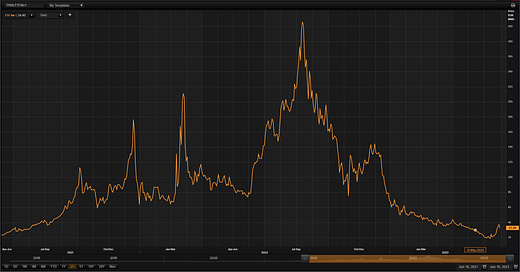Ten months ago the European benchmark Dutch TTF front-month gas contract reached an all-time high above €340 per MWh. As of a week ago European natural gas prices had slumped more than 90% as European gas inventories surged.
Natural gas inventories are estimated to be around 70% full, well on schedule to achieving the EU’s target of filling storage to at least 90% by 1st November. A slump in industrial demand for natural gas and the lack of any sustained demand for LNG from Asia helped support stock levels, soothing the worries of gas traders concerned about next winter.
The slump in natural gas prices was so deep that it provided a big incentive for utilities to switch from burning thermal coal and lignite to natural gas. Burning natural gas is of course significantly less carbon intensive than generating power using thermal coal or lignite. In response, demand for EUAs from utilities wanting to cover their emissions has waned.
In the week ending 2nd June Commitment of Traders (COT) data shows that investment funds had built up a record short position in the EU carbon market totalling 25.4 million EUA’s, traders betting that there was more fuel switching to come. The selling pressure was enough to push the carbon price below the $80 per tonne level, hitting levels which have offered support since early 2022.
However, a doubling in European natural gas prices over the past week has caused turmoil in the EU carbon market with the EUA price jumping ~€15 as funds looked to cover their short positions.
The initial spark was an announcement by Gassco, the Norwegian infrastructure operator, that it was postponing the restart of the Nyhamna gas processing plant from 21st June 15th July. A few days later the Dutch government announced that the Groningen gas field, the largest in Europe will permanently shutdown in October; ministers had previously announced that production at the field would end by 1st October 2024 at the latest.
The jolt has reawakened fears that a resumption in LNG cargo interest from north-east Asian buyers could put the European stock position at risk as we head towards winter.
The latest COT report (w/e Friday 9th June) shows that investment funds began to cut their record short position by 5.3 million EUAs to 20.1 million EUAs. By the end of last week carbon had rebounded to $87 per tonne breaking back up through the 200-day moving average and the 23 and 30-day exponential moving average.
Moving beyond those key technical indicators was enough to support further gains. Breaching the bullish wedge that had gradually formed since late February provided extra fuel for the upside. At the end of April I highlighted early June and the $80 level as a point to watch out for a rebound in the market (see Investment funds ditch carbon after failure to decisively breach €100).





